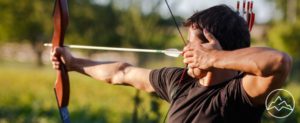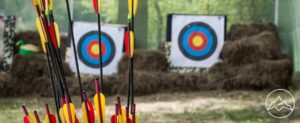In the world of archery, ILF bows have gained significant popularity due to their versatility and customization options. These bows, also known as the Hoyt Dovetail System (HDS), were invented by Earl Hoyt in the early 1980s and have revolutionized the way archers approach their sport. One prime example of the ILF bow’s excellence lies in its International Limb Fitting (ILF), which allows for the interchangeability of limbs and risers. This feature enables archers to mix and match different components, thereby finding the ideal draw weight and adjusting the draw length to suit their personal preferences. The ILF bow simplifies the tuning process and offers adaptability through tiller adjustments, ensuring comfortable aiming for archers. Furthermore, ILF bows are highly convenient for transportation and maintenance, as they can be easily broken down and replaced with damaged limbs. By understanding the intricacies of ILF bows, archers can make informed decisions when purchasing risers and limbs, ultimately enhancing their shooting experience and long-term use in the realm of archery.
Key Takeaways
- ILF bows, also known as the Hoyt Dovetail System (HDS), are a type of recurve bow that offers adaptability and simplify the tuning process.
- ILF bows allow archers to mix and match risers and limbs, providing flexibility and adjustment options.
- ILF bows make it easier to find the ideal draw weight and offer customization options.
- ILF bows are versatile and adaptable, supporting better shooting and long-term use in archery.
What are ILF Bows?
ILF bows, also known as the Hoyt Dovetail System (HDS), are a type of recurve bow that offer interchangeability of limbs and risers, providing archers with adaptability, customization, and improved shooting capabilities. ILF bow technology allows archers to mix and match different risers and limbs, making it easier to find the ideal draw weight and draw length. This feature has contributed to the popularity of ILF bows among recurve archers. The International Limb Fitting (ILF) system was invented by Earl Hoyt in the early 1980s, revolutionizing the world of archery. ILF bows simplify the tuning process and allow for fine-tuning adjustments, such as tiller adjustments, which ensure comfortable aiming. Moreover, ILF bows are easy to break down and transport, as they can be disassembled into smaller pieces. Additionally, ILF bows offer the advantage of replacing damaged limbs instead of the entire bow, saving both time and money. Overall, ILF bows provide archers with the versatility and adaptability needed for customizable recurve excellence.
Advantages of ILF Bows
One of the advantages of the International Limb Fitting (ILF) system is its ability to easily interchange risers and limbs, allowing archers to experiment and find the best combination for their shooting style. This feature is particularly beneficial for beginners who are still discovering their preferences and adjusting to the sport. ILF bows offer a wide range of customization options, allowing archers to fine-tune their equipment to their specific needs. The ability to adjust the draw weight and draw length of ILF bows makes them suitable for archers of different skill levels and physical abilities. Additionally, ILF bows simplify the tuning process, as limb replacements can be made without having to purchase an entirely new bow. The versatility and adaptability of ILF bows make them an excellent choice for archers who value flexibility and long-term use in the sport.
Choosing the Right ILF Bow
When selecting an ILF bow, archers must consider factors such as limb draw weight, draw length, and personal shooting style to ensure optimal performance. Draw weight considerations are crucial as it determines the force required to fully draw the bow. Beginners are recommended to start with a draw weight of around 20-25 pounds to develop proper form and technique. As archers progress, they can gradually increase the draw weight to suit their strength and shooting abilities. Additionally, ILF bow accessories play a significant role in enhancing the archer’s experience. Popular accessories include stabilizers, sights, arrow rests, and clickers. These accessories can improve stability, accuracy, and consistency in shooting. It is essential for archers to carefully choose and customize their ILF bow and accessories to meet their specific needs and shooting style.
Frequently Asked Questions
Can ILF limbs be used on traditional recurve bows?
ILF limbs are not compatible with traditional recurve bows. ILF bows have a specific limb fitting system that allows for interchangeability of limbs and risers. Traditional recurve bows do not have this feature and are not designed to accommodate ILF limbs. While ILF bows offer flexibility and customization options, traditional recurve bows require specific limbs designed for their particular model. Therefore, modifications would be necessary to make ILF limbs compatible with traditional recurve bows.
What are the benefits of using an ILF bow over a one-piece recurve bow?
A bird in the hand is worth two in the bush when it comes to the benefits of using an ILF bow over a one-piece recurve bow. ILF bows offer numerous advantages, including the ability to interchange limbs and risers, allowing archers to customize their bow according to their preference. This flexibility makes ILF bows suitable for different archery styles, whether it be target shooting or hunting. Additionally, ILF bows simplify the tuning process and offer better shooting and long-term use in archery.
Are all ILF risers compatible with all ILF limbs?
The compatibility of ILF risers and limbs varies depending on the specific measurements and designs of each manufacturer. While ILF bows offer the interchangeability of limbs and risers, not all ILF limbs are compatible with all ILF risers due to differences in measurements. It is important for archers to carefully consider the compatibility of ILF risers and limbs when making their purchasing decisions. In contrast, traditional recurve bows do not offer the same level of interchangeability and customization options as ILF bows.
How often should ILF bow limbs be replaced?
How often should ILF bow limbs be replaced? The durability of ILF bow limbs varies depending on factors such as usage, maintenance, and the quality of the limbs. Signs of wear on ILF bow limbs may include delamination, cracks, or loss of performance. Regular inspection is recommended to identify any damage or wear. Replacement should be considered when the limbs show significant signs of wear or if performance is compromised.
Can ILF bows be used for hunting as well as target shooting?
ILF bows can be used for both hunting and target shooting due to their versatility. The interchangeable risers and limbs of ILF bows allow for customization, making them suitable for different shooting styles. When discussing hunting with ILF bows, it is important to consider factors such as draw weight and draw length, as they affect the bow’s performance in the field. Additionally, ILF bows offer adaptability and simplify the tuning process, enhancing the shooting experience in various settings.
Conclusion
In conclusion, ILF bows, also known as the Hoyt Dovetail System, offer archers a versatile and customizable recurve bow option. With the International Limb Fitting, archers can easily interchange limbs and risers to find the ideal draw weight and adjust the draw length according to personal preference. The advantages of ILF bows include easy tuning, adaptability through tiller adjustments, and the ability to replace damaged limbs instead of the entire bow. When choosing an ILF bow, it is important to consider limb draw weight and draw length for optimal shooting and long-term use. Are you ready to elevate your archery experience with the customizable excellence of ILF bows?












